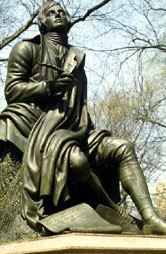Anyone who has seen a group of Elizabeth Bishop's drafts of a single poem can appreciate the painstaking attention to detail she took. The first draft or two may seem an unimpressive blurb scrawled out over a page of notepad, nothing like the final masterpiece at all. At some point she might even begin mapping out the beginning and ending words of particular lines, leaving the rest blank, as if she were playing some sort of word game, rather than composing them through from beginning to end, as one might expect. Over time, and many drafts, the piece begins to take shape, until wammo, all the parts in the puzzle click, and voila, we have a gorgeous gem like "One Art." But the process is nothing like what one might expect, none of the flighty spontaneity one sees in the statue of Robert Burns
 in Central Park's (NYC) Mall and Literary Walk. It is, in fact, quite the opposite of John Ashbery's process, or at least his process as he describes it -- the cutting of the tape of poetry that runs through his mind at all times. Ashbery claims that he will not write by hand, but uses a typewriter, because he would otherwise miss something, he moves so quickly through his lines. It's paradoxical that Bishop is one of his favorite poets, but this is what he says.
in Central Park's (NYC) Mall and Literary Walk. It is, in fact, quite the opposite of John Ashbery's process, or at least his process as he describes it -- the cutting of the tape of poetry that runs through his mind at all times. Ashbery claims that he will not write by hand, but uses a typewriter, because he would otherwise miss something, he moves so quickly through his lines. It's paradoxical that Bishop is one of his favorite poets, but this is what he says.It is paradoxical too, that what Bishop was after was a representation of what she called mind in action. She actually wanted to create the sense of a mind happening across its various discoveries, perceptions, choices and distinctions in time. Such a goal might be best served using Ashbery's methodology, we might think, just as Andre Breton argued in his manifestoes about the use of automatic writing.
During the mid 1970's Richard Bandler and John Grinder learned to replicate the behaviors of some of the most successful psychotherapists at the time, including the legendary Milton Erickson, by using mimicry. Instead of reading walls of theory texts, they simply imitated the therapists' "micro-muscle movements," i.e. the barely noticable flexings of muscles below the flesh of the face, as well as gestures of the rest of the body, in time, while observing their work. They would then pretend they were the person they had observed and try to get the same result, and often, they would. Not only did they learn anatomical behaviors, as one may expect, but also arrangements of complex linguistic patterns as well.
This may perhaps be explained by mirror neurons, a kind of nerve cell discovered during the early 1990's in Italy, and now the center of every discussion from learning theory to the causes of autism.
Only after learning the behaviors did Bandler and Grinder try to figure out what patterns they were in fact using. Once they did, they began teaching others, and their students all seemed to get more or less the same results.
Grinder and Bandler called this process of learning new behaviors modeling. Later on, they developed a short cut methodology which involved tracking the sequence of a person's sensory modulatities during a thought or behavior process. For instance, someone might see a particular image (visual), to which they have a particular physiological response (kinesthetic), which they would respond to by forming particular words (auditory digital). They would map this sequence textually as V->K->A-d. These sequences could be very complex, and involve loops and curlicues, and different qualities and intensities, and often were not actually sequences at all, but coded cybernetic processes running in parallel. They would often be very contextualized, meaning you might use one particular coding to decide what was real vs. imaginary when you are sitting in your cubicle, and another when you are out for a walk. They called these grouped processes strategies.
One of my favorite ways of tracking strategies was developed by Jonathan Altfeld, an NLP trainer, who at one point used a similar methodology to develop artificial intelligence systems.